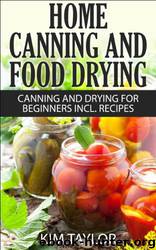Home Canning and Food Drying, Canning and Drying for Beginners, Plus Recipes by Kim Taylor

Author:Kim Taylor [Taylor, Kim]
Language: eng
Format: epub
Tags: Cookbooks; Food & Wine, Canning & Preserving, Cooking Methods, Kitchen Appliances, Dehydrators, Culinary Arts & Techniques
Amazon: B00JUW3O7A
Published: 2014-04-21T04:00:00+00:00
Recipe for Sauerkraut
This recipe will yield approximately 9 quarts of Sauerkraut.
You will need
25 lbs of fresh, firm cabbage
¾ cup of pickling or canning salt.
As always, the sooner you can your food after harvesting the better the product.
1. It is best to work with 4 to 5 heads of cabbage at a time. 4 to 5 heads gives you approximately 1 ½ to 1 ¾ quarts. Obviously this will vary a little depending on the size and the quality of the cabbage used.
2. Remove outer leaves. Thoroughly rinse the heads under cold water and drain.
3. Cut into quarts and remove cores. Shred and slice to preferred thickness.
4. Rinse again under cold water and drain off.
5. Place clean, shredded cabbage in a suitable container and add 3 tablespoons of salt to top of cabbage.
6. Thoroughly mix the cabbage and the salt.
7. Firmly push the cabbage down so that you pack it as tightly as possible.
8. The salt should start drawing juices from the shredded cabbage.
9. You now need to repeat steps 2 to 6 until all of your cabbage is in the container.
10. If your cabbage is less than 4 to 5 inches from the top of the container you will need to transfer it to another larger container.
11. At this stage your cabbage should be covered with the extracted juices. If not, you will need to prepare some brine for adding to the container.
To do this make a solution of water and salt at a rate of 1 ½ tablespoons of slat per quart of water. Bring this to the boil and then let it cool down. When it has cooled you can add it to your container of cabbage.
12. The cabbage now needs to be weighed down. To do this you simply cover the cabbage with a plate and place weights on top of the plate, (see methods earlier on for the best way to do this, I recommend using food grade plastic bags containing brine, as weights).
13. When cabbage is weighed down you need to cover the container itself. Use a clean, non-perfumed large bath towel.
14. Store your fermenting cabbage for 3 to 4 weeks at a temperature range of 7o to 75. You can store it a temperature range of 60 to 65 but it will take 5 to 6 weeks to ferment.
15. If it is stored at temperatures in excess of 75 the sauerkraut will be soft. Temperatures below 60 and it is unlikely that your food will ferment.
16. If you used the brine filled bags as suggested you will not need to disturb the cabbage until fermentation has completed. You will know when it is completed as it will no longer be bubbling.
If you used jars as a weight you need to check your produce 3 times weekly and remove scum.
17. Sauerkraut can be stored in a refrigerator for several months if it is kept tightly covered. Canning instructions for sauerkraut are below.
Download
This site does not store any files on its server. We only index and link to content provided by other sites. Please contact the content providers to delete copyright contents if any and email us, we'll remove relevant links or contents immediately.
My Pantry by Alice Waters(2542)
The Culinary Herbal by Susan Belsinger(2429)
Food and Water in an Emergency by Food & Water In An Emergency(2338)
Asian Pickles: China by Karen Solomon(2093)
Project Smoke by Steven Raichlen(1995)
Food Storage for Self-Sufficiency and Survival by Angela Paskett(1985)
Smoke & Spice by Cheryl Alters Jamison(1882)
The Jam and Marmalade Bible by Jan Hedh(1613)
Pure Charcuterie: The Craft & Poetry of Curing Meat at Home by Meredith Leigh(1607)
Fermented Vegetables by Kirsten K. Shockey(1521)
Economic Food Storage Strategies for Disaster Survival: Start Today and Have Enough Food Your Family Will Eat to Survive Any Disaster Without Going Broke by Sandy Gee(1504)
Asimov's Science Fiction 020111 by Dell Magazines(1503)
Asian Pickles by Karen Solomon(1451)
Canning for a New Generation by Liana Krissoff(1414)
The Ideal Pantry: Your Comprehensive Guide to Food Remedies and Preservation Techniques by Ben Night(1412)
The Healthy Meal Prep Cookbook: Easy and Wholesome Meals to Cook, Prep, Grab, and Go by Amidor RD CDN Toby(1394)
Not Just Jam: The Fat Pig Farm book of preserves, pickles and sauces by Evans Matthew(1367)
The Complete Guide to Drying Foods at Home: Everything You Need to Know About Preparing, Storing, and Consuming Dried Foods by Paajanen Terri(1313)
Jams, Preserves and Chutneys by Marguerite Patten(1304)
